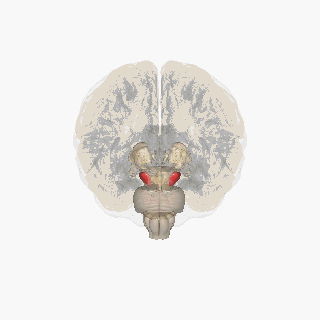Substantia nigra
| Substantia nigra | |
|---|---|

Substantia nigra highlighted in red.
|
|

Section through superior colliculus showing Substantia nigra.
|
|
| Details | |
| Part of | Midbrain, Basal ganglia |
| Identifiers | |
| Latin | Substantia nigra |
| MeSH | A08.186.211.132.659.687 |
| NeuroNames | hier-527 |
| NeuroLex ID | Substantia nigra |
|
Anatomical terms of neuroanatomy
[]
|
|
The substantia nigra is a brain structure located in the mesencephalon (midbrain) that plays an important role in reward and movement. Substantia nigra is Latin for "black substance", reflecting the fact that parts of the substantia nigra appear darker than neighboring areas due to high levels of neuromelanin in dopaminergic neurons. It was discovered in 1784 by Félix Vicq-d'Azyr, and Samuel Thomas von Sömmerring alluded to this structure in 1791.Parkinson's disease is characterized by the death of dopaminergic neurons in the substantia nigra pars compacta.
Although the substantia nigra appears as a continuous band in brain sections, anatomical studies have found that it actually consists of two parts with very different connections and functions: the pars compacta and the pars reticulata. This classification was first proposed by Sano in 1910. The pars compacta serves mainly as an input to the basal ganglia circuit, supplying the striatum with dopamine. The pars reticulata, though, serves mainly as an output, conveying signals from the basal ganglia to numerous other brain structures.
The substantia nigra, along with four other nuclei, is part of the basal ganglia. It is the largest nucleus in the midbrain, lying dorsal to the cerebral peduncles. Humans have two substantiae nigrae, one on each side of the midline.
The substantia nigra is divided into two parts: the pars reticulata and pars compacta, which lies medial to the pars reticulata. Sometimes, a third region, the pars lateralis, is mentioned, though it is usually classified as part of the pars reticulata. The pars reticulata and the internal globus pallidus are separated by the internal capsule.
...
Wikipedia
